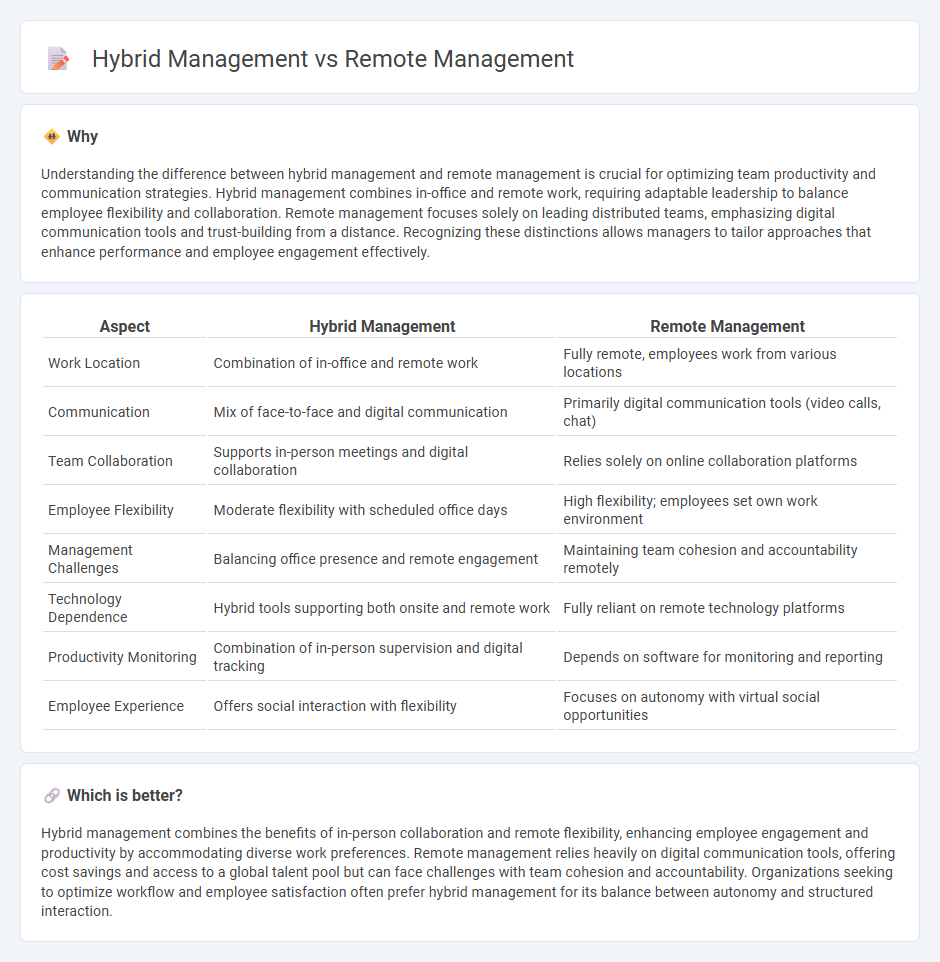
Hybrid management combines in-person and remote work strategies to enhance flexibility and employee engagement, balancing collaboration with autonomy. Remote management relies entirely on digital communication and virtual tools to oversee distributed teams, emphasizing trust and clear performance metrics. Explore how these approaches impact productivity and team dynamics in diverse work environments.
Why it is important
Understanding the difference between hybrid management and remote management is crucial for optimizing team productivity and communication strategies. Hybrid management combines in-office and remote work, requiring adaptable leadership to balance employee flexibility and collaboration. Remote management focuses solely on leading distributed teams, emphasizing digital communication tools and trust-building from a distance. Recognizing these distinctions allows managers to tailor approaches that enhance performance and employee engagement effectively.
Comparison Table
| Aspect | Hybrid Management | Remote Management |
|---|---|---|
| Work Location | Combination of in-office and remote work | Fully remote, employees work from various locations |
| Communication | Mix of face-to-face and digital communication | Primarily digital communication tools (video calls, chat) |
| Team Collaboration | Supports in-person meetings and digital collaboration | Relies solely on online collaboration platforms |
| Employee Flexibility | Moderate flexibility with scheduled office days | High flexibility; employees set own work environment |
| Management Challenges | Balancing office presence and remote engagement | Maintaining team cohesion and accountability remotely |
| Technology Dependence | Hybrid tools supporting both onsite and remote work | Fully reliant on remote technology platforms |
| Productivity Monitoring | Combination of in-person supervision and digital tracking | Depends on software for monitoring and reporting |
| Employee Experience | Offers social interaction with flexibility | Focuses on autonomy with virtual social opportunities |
Which is better?
Hybrid management combines the benefits of in-person collaboration and remote flexibility, enhancing employee engagement and productivity by accommodating diverse work preferences. Remote management relies heavily on digital communication tools, offering cost savings and access to a global talent pool but can face challenges with team cohesion and accountability. Organizations seeking to optimize workflow and employee satisfaction often prefer hybrid management for its balance between autonomy and structured interaction.
Connection
Hybrid management integrates on-site and remote work strategies, enabling seamless collaboration and flexibility across diverse teams. Remote management focuses on leading geographically dispersed employees using digital tools, which are essential components within the hybrid model. Both approaches rely on communication technology and performance monitoring systems to optimize productivity and employee engagement.
Key Terms
Communication Tools
Remote management relies heavily on digital communication tools such as video conferencing, instant messaging, and collaboration platforms to maintain team cohesion and productivity across different locations. Hybrid management integrates both in-office and remote communication tools, prioritizing flexible solutions like seamless video calls, shared cloud workspaces, and real-time messaging to support diverse work environments. Explore comprehensive comparisons of leading communication tools to optimize your remote or hybrid management strategy.
Employee Autonomy
Remote management enables employees to exercise greater autonomy by allowing flexible work hours and self-directed task completion, fostering increased job satisfaction and productivity. Hybrid management balances autonomy with structured in-office collaboration, supporting both independent work and team synergy. Discover how optimizing these approaches can enhance employee autonomy and organizational success.
Workplace Flexibility
Remote management enhances workplace flexibility by allowing employees to work from any location, increasing autonomy and reducing commute times. Hybrid management combines remote and in-office work, fostering collaboration while maintaining flexibility and work-life balance. Explore how adopting either model can optimize productivity and employee satisfaction.
Source and External Links
Remote Management: Key Benefits, Challenges & Best Practices - This article discusses the benefits and challenges of remote management, including its applications across various industries like IT support and healthcare system maintenance.
Remote Monitoring and Management - Remote monitoring and management (RMM) involves supervising and controlling IT systems remotely, allowing for tasks like software updates and performance monitoring.
Enable Remote Management for Remote Desktop - This guide provides instructions on how to enable remote management for Apple computers, allowing administrators to define access privileges and manage devices remotely.
 dowidth.com
dowidth.com